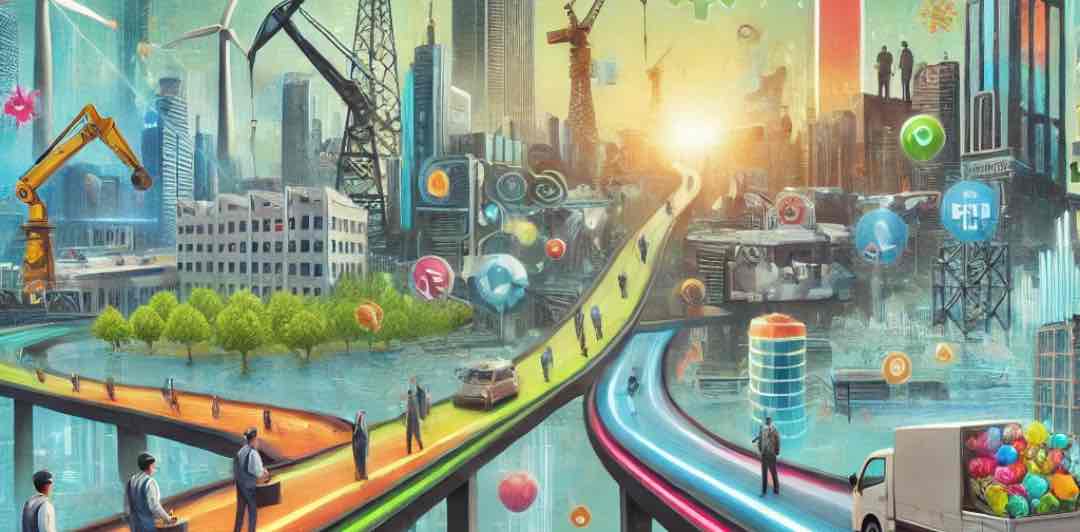
Today is the third lecture in the “Employment Change” series. Let’s start with a current reality, that is, the traditional reservoir of employment is becoming more and more saturated, and the country is eager to find a new reservoir of employment.
What kind of employment trend does this reality represent? And what impact will it have on you? Let’s talk about these issues today.
The traditional employment reservoir is gradually saturated
Let’s start with a seemingly insignificant piece of news.
In December 2024, Hefei City issued a “Warning for the Online Car-hailing Industry”. According to Hefei officials: At present, the online car-hailing market in Hefei has shown the characteristics of “intensified market competition, high vehicle idling rate, and declining income of employees”. The average daily order of online car-hailing drivers is only 11.5 orders, and the empty car rate is 45%.
Let’s look at another amazing number. Drivers with an average daily turnover of less than 300 yuan account for nearly 80% of the total. If the driver works 12 hours a day, this is equivalent to only 25 yuan per hour. After deducting various fees such as gas, electricity, car rental fees, platform deductions, etc., the actual money received by the driver may be less than 15 yuan per hour, which is lower than the local minimum hourly wage. In other words, after working hard for a month, he may barely earn 5,000 yuan.
Not only in Hefei, the phenomenon of online car-hailing drivers “not making money” continues to occur in many places: for example, official data from Suqian shows that the average daily number of orders for local online car-hailing is only 10, and drivers spend a long time on the road looking for orders, and the vehicles are largely idle. For example, the official report of Yingtan, Jiangxi, shows that the average daily turnover of local online car-hailing drivers is less than 200 yuan, and more than 60% of them have less than 10 orders per day.
As a result, a large number of cities and regions began to issue “online car-hailing industry warnings” to remind people of the risks they need to pay attention to when entering the industry. This includes nearly 100 cities in more than 20 provinces, including Chongqing, Suzhou, Suqian, Haikou, Jingdezhen, Shijiazhuang, Jinan, and Urumqi.
According to official data, there are now more than 7 million online car-hailing drivers nationwide, compared to less than 3.5 million three years ago, a doubling in just three years. At present, the average daily order volume of the entire industry is only 24 million orders, and the average income of each driver is close to the minimum hourly wage. This is the real situation of the online car-hailing industry.
Of course, the online car-hailing industry we are talking about today is just a microcosm of the current situation of many industries, from which we can see that the traditional reservoir of employment is becoming more and more saturated.
Two trends about employment
So what trends are reflected behind this situation?
The first trend is that the downgrade of middle-class employment has brought about a chain reaction.
A further explanation is that the middle-level positions of small and medium-sized enterprises are collapsing in batches, resulting in the employees of private small and medium-sized enterprises, which are the basic employment base, facing unemployment. However, state-owned enterprises and foreign companies cannot absorb so many unemployed people in the middle class, so “employment crowding” has emerged, that is, the middle class or the middle-level people in enterprises “downgrade employment” to squeeze the opportunities of the middle and lower classes.
And this “employment downgrade” will then bring about “consumption downgrade” and “investment downgrade”, and the wealth structure may change from “inverted pyramid” to “inverted thumbtack shape”. To put it bluntly, it is a series of chain reactions caused by the decline of the middle class. The biggest impact is the economic and employment problems caused by insufficient consumption, which is simply rolling down.
The second trend is that the turning point of human depreciation has arrived.
I believe you should have also felt some signals: domestic academic involution, the high imbalance between the cost and income of overseas students, and the phenomenon of unemployment at the age of 35, etc.
Why does this phenomenon occur? It is largely influenced by the concept of “education investment theory”.
In 2001, after joining the WTO, China ushered in a 20-year “human resource appreciation” stage, which promoted the formation of the urban middle class and formed the people’s deep-rooted “education investment theory”.
China’s higher education has experienced decades of rapid development. The concept of education investment has been deeply rooted in people’s hearts. The number of highly educated talents and urban white-collar workers has continued to increase, and the supply has greatly exceeded market demand. Moreover, this oversupply is still accelerating, causing many unemployed people to “downgrade their employment” and choose online car-hailing, food delivery and other occupations, which indirectly reduces income and consumption. This in turn affects the revenue of small and medium-sized enterprises, resulting in a decline in business conditions and the need to lay off employees and reduce costs, forming a chain reaction.
However, more basic vocational education has continued to decline under the concept of “education investment theory”, and the supply of blue-collar groups is far less than the basic needs of the current society.
On the one hand, there are college students who are crowded in the job market and eager to find white-collar positions with a monthly salary of three to four thousand yuan, while on the other hand, there are construction industries and production lines that cannot find young workers and have a large number of vacant blue-collar positions. The polarization of employment difficulties and recruitment difficulties is intensifying in a split manner.
This is like a person eating, you need rice, meat, and vegetables. Originally you only need one dish, but now you have four or five dishes, and there is only half a bowl of rice and a few pieces of meat, so the extra dishes can only be thrown away. The dishes thrown away here are the surplus white-collar workers; the high-end talents in science and engineering are meat; and the blue-collar workers are the staple food. The current job market is that there are a lot of vegetables, but very little meat and rice, so the vegetables are becoming less and less valuable.
Therefore, compared with the economic impact that the unemployment rate may have, what is more worrying at the moment is actually the structural imbalance of employment and the imbalance between higher education and vocational education behind it.
How to reshape future education and employment?
Based on this current situation and trend, we can foresee that the pattern of education and career choice in the future will be reshaped. How to reshape it?
Based on the existing policy information, I see that the central government currently has two focus points:
The first focus point is to construct a new employment reservoir as soon as possible to absorb a large number of unemployed people.
The domestic service industry may be a new employment reservoir, because since the second half of last year, major ministries and commissions have intensively issued important documents on supporting the domestic service industry to absorb employment:
The Ministry of Commerce and other 9 departments issued the “2024 Domestic Service Agricultural Development Action Work Plan”, requiring the active absorption of people who have escaped poverty and rural migrant workers; the Ministry of Human Resources and Social Security and other 7 departments issued the “Opinions on Strengthening the Professionalization of Domestic Services”, requiring large-scale promotion of domestic personnel training and absorption of mobile unemployed and flexible employment population; the National Development and Reform Commission and other 5 departments issued the “Opinions on Deepening the Integration of Industry and Education in the Domestic Service Industry”, requiring the deepening of industry-education integration, and the addition of domestic service-related majors in ordinary colleges and vocational education.
Simply put, it is to make the domestic service industry an employment reservoir that absorbs various groups from low to high, such as rural population, urban unemployed population, and college graduates.
The second focus is to carry out education diversion. Diversion starts from the high school entrance examination. Some people continue to receive higher education to become white-collar workers, and others receive vocational education to become blue-collar workers.
The central government has previously issued the “National Vocational Education Reform Implementation Plan”, which mentioned “improving the high-level application-oriented talent training system and carrying out undergraduate vocational education pilot projects. Establishing the “Vocational Education College Entrance Examination” system, improving the “cultural quality + vocational skills” examination and enrollment method, and providing students with multiple ways to receive vocational education.”
Simply put, it is to provide a new way for the development of vocational education by carrying out undergraduate vocational education pilot projects and establishing the “Vocational Education College Entrance Examination” system, guiding some students to enter the vocational education system, and cultivating high-level blue-collar talents.
So, what impact will these two directions have?
First, the purpose of constructing a new employment reservoir is of course to absorb employment. With housekeeping as the main focus, the trend will be: in the future, unemployed urban white-collar men may find it more difficult to find jobs than women. I think this is mainly because women are relatively more likely to join the housekeeping industry and will not have such a strong fear of difficulties.
Secondly, education diversion is very consistent with our current social situation of “white-collar surplus and blue-collar shortage”. There are two types of employment groups that are likely to be popular in the future: one is top science and engineering talents, who are the top white-collar workers and can get the dividends of the times in the atmosphere of technological innovation. The other is senior blue-collar workers, who are currently in short supply and have a huge employment dividend. Moreover, in developed European and American societies, blue-collar workers are more popular than white-collar workers. I think that this trend will gradually continue in China in the future.
Two employment suggestions
Finally, let’s talk about what changes and preparations individuals can make in the face of the current situation. I will give you two more practical suggestions for your reference:
First, for those who are considering entering the new employment reservoir industry, you need to change your mindset.
For example, if you plan to join the housekeeping industry, you need to realize that the future housekeeping industry is not a traditional simple labor service, but a service industry with technical content. With the improvement of the quality of practitioners in the housekeeping industry, higher demands will naturally arise. In the future, housekeeping will be generalized and the breadth of services will increase. This is an inevitable trend. Just like many tour guides now have master’s degrees in history, and the explanations they provide are all accompanied by academic debates and analysis. In the future, an excellent domestic worker can also become a tutor for children. And as the scale of the domestic industry expands, more general management positions or system support positions will be generated.
The second suggestion is that if you are a young person who is facing education diversion and considering entering the vocational education track, I suggest that you try to choose a major that is closely related to the development of the local industry.
For example, in areas with developed manufacturing industries, you can choose majors such as CNC processing and mold manufacturing; in areas with rich tourism resources, you can choose majors such as tourism services and management, hotel management, etc. And it is recommended that you try to choose your hometown, so that you can save the cost of settling in other cities. Employment orientation is eight words: seek truth from facts and adapt to local conditions.
If you are a parent, when raising a child, you should pay special attention to whether he is better at hands-on or better at brains. It is much more important to figure out which bowl of rice your child can eat than to pile up resources blindly and go to an ordinary undergraduate major regardless of cost-effectiveness. We don’t make things difficult for our children, and we don’t make things difficult for ourselves.



